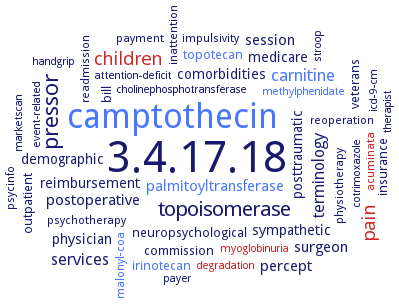3.4.17.18: carboxypeptidase T
This is an abbreviated version!
For detailed information about carboxypeptidase T, go to the full flat file.

Word Map on EC 3.4.17.18 
-
3.4.17.18
-
camptothecin
-
pressor
-
topoisomerase
-
children
-
pain
-
carnitine
-
services
-
terminology
-
percept
-
session
-
palmitoyltransferase
-
surgeon
-
postoperative
-
sympathetic
-
physician
-
demographic
-
medicare
-
reimbursement
-
comorbidities
-
posttraumatic
-
bill
-
irinotecan
-
topotecan
-
veterans
-
outpatient
-
commission
-
insurance
-
neuropsychological
-
reoperation
-
psycinfo
-
physiotherapy
-
acuminata
-
readmission
-
payment
-
impulsivity
-
psychotherapy
-
malonyl-coa
-
inattention
-
handgrip
-
cotrimoxazole
-
methylphenidate
-
cholinephosphotransferase
-
event-related
-
myoglobinuria
-
attention-deficit
-
stroop
-
icd-9-cm
-
degradation
-
marketscan
-
therapist
-
payer
- 3.4.17.18
- camptothecin
-
pressor
-
topoisomerase
- children
- pain
- carnitine
-
services
-
terminology
-
percept
-
session
- palmitoyltransferase
-
surgeon
-
postoperative
-
sympathetic
-
physician
-
demographic
-
medicare
-
reimbursement
-
comorbidities
-
posttraumatic
-
bill
- irinotecan
- topotecan
-
veterans
-
outpatient
-
commission
-
insurance
-
neuropsychological
-
reoperation
-
psycinfo
-
physiotherapy
- acuminata
-
readmission
-
payment
-
impulsivity
-
psychotherapy
- malonyl-coa
-
inattention
-
handgrip
-
cotrimoxazole
- methylphenidate
-
cholinephosphotransferase
-
event-related
- myoglobinuria
-
attention-deficit
-
stroop
-
icd-9-cm
- degradation
-
marketscan
-
therapist
-
payer
Reaction
releases a C-terminal residue, which may be hydrophobic or positively charged =
Synonyms
carboxypeptidase SG, carboxypeptidase T, CPT, metallocarboxypeptidase T
ECTree
Advanced search results
Crystallization
Crystallization on EC 3.4.17.18 - carboxypeptidase T
Please wait a moment until all data is loaded. This message will disappear when all data is loaded.
carboxypeptidase T complexes with substrate analogs benzylsuccinic acid and (2-guanidinoethylmercapto)succinic acid by molecular replacement at resolutions of 1.57 A and 1.62 A. The conservative Leu211 and Leu254 residues are structural determinants for recognition of hydrophobic substrates, whereas Asp263 is for recognition of positively charged substrates. The Pro248-Asp258 loop interacting with Leu254 and Tyr255 is responsible for recognition of the substrate's C-terminal residue. Substrate binding at the S10 subsite leads to the ligand-dependent shift of this loop, and Leu254 side chain movement induces the conformation rearrangement of the Glu277 residue crucial for catalysis
crystals of carboxypeptidase T complexes with the transition-state analogs N-sulfamoyl-L-arginine and N-sulfamoyl-L-phenylalanine are grown in microgravity in a capillary using the counter-diffusion technique. Conformation of the transition state analogue of the hydrophobic substrate in the complex with carboxypeptidase T is similar to that of the ground state analogue
crystals of the mutant enzyme A243G complexed with N-sulfamoyl-L-phenylalanine are formed under the microgravity conditions by the method of counterx02diffusion through a gel layer in a capillary. The structure of the complex of the CPT G215S/A251G/T257A/D260G/T262D mutant with the transition state analogue N-sulfamoyl-L-phenylalanine is solved at a resolution of 1.35 A and compared it with the structure of similar complex formed by carboxypeptidase T
in complex with N-benzyloxycarbonyl-L-leucine, at 1.38 A resolution. The structure of the complex is almost identical to that of the free carboxypeptidase T molecule, and a SO42- ion is also localized in the active site. The S1 subsite of carboxypeptidase T is a very conservative structure and negligibly differs from corresponding sites of carboxypeptidase A and carboxypeptidase B in the composition and the 3D structure. The S1 subsite is close to the catalytic zinc ion and to the residues Arg71, Arg147, Arg129, and Glu277 important for catalysis
mutant enzyme G215S/A251G/T257A/D260G/T262D is crystallized and its three-dimensional structure is determined at 1.29 A resolution by X-ray crystallography. The S1' subsite of carboxypeptidase T has not been distorted by the mutagenesis and adequately reproduces the structure of the CPB S1' subsite


 results (
results ( results (
results ( top
top





